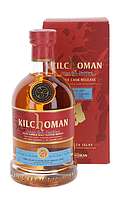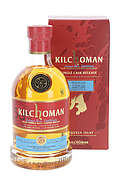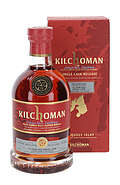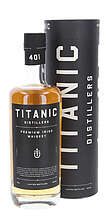Bottles without age information
A new trend! Whiskies without an age statement!
We are often asked how old a whisky in a bottle without an age statement is. In recent years, many of these 'No Age Statements' (NAS) have appeared on the market. This question is not so easy to answer. Even insiders often do not know which casks were bottled specifically for these bottles and at what age. Find out more about the background here.
The second video on this topic is more about the commercial and company-political view of age indications on whisky bottles.
Facts about barrel ageing and age specifications
Firstly, it is important to know the facts: According to Scottish law, a whisky must mature for at least three years and one day in order to be called whisky. Based on this, whiskies without an age statement are at least three years old.
Another important law is that if whiskies are blended from several casks of different ages, the age of the youngest cask must be stated when the age is mentioned. With this background knowledge, let's take a closer look at the topic.
Why the question about age?
It is interesting to note the motivation behind the question of age. Most of the questioners want to determine the value of the whisky based on its age. According to the motto 'old whiskies are better'. As the price of many whiskies increases with age, this view is not unfounded. Unfortunately, it is not always possible to make such a generalised statement. If we look at how cask maturation works, we see that with additive and subtractive maturation, a whisky can also mature 'too long' in the cask. The whisky then absorbs too many oak flavours from the cask. Of course, this depends on each cask itself and how often it has been used. Nevertheless, age is an important marketing tool for bottlings and many customers attach importance to it.
Reasons for missing age information
Hiding your age
It's obvious: most distilleries don't give an age to hide a young age. A single-digit number doesn't look as good as a two-digit number. In the 1990s and 2000s, there were bottlings from Macallan and Glen Grant, among others, that stated an age of five or seven years. But as the 12, 15 and 18-year-olds were more in demand on the market, the young age was omitted from subsequent bottlings.
Use of young barrels
Another reason for not mentioning the age can be the use of young barrels. Sometimes an older, milder cask is refreshed with young, more intense casks. There is also the fact that a whisky matures faster in a young cask. But as already mentioned, the age of the youngest cask must then be stated, which brings us back to the first reason.
Another bonus at this point is also the reduction in cost, as an old, expensive cask is blended with a cheap, young one. This works best with smoky whisky, as the young, 'metallic' character of the distillery can be more easily hidden in a smoky malt.
The duration of post-ripening
Whisky is often matured in different casks such as sherry or wine casks. The duration of the secondary maturation is usually shorter than the original maturation and in some cases can only last a few months. Each time a cask is used, the length of maturation required for the whisky to achieve the same strength of flavour increases. For example, the first use of the cask will take six months, the second eight months, the third 12 months and so on. This becomes a problem with standard bottlings with post-maturation, such as the Laphroaig Quarter Cask. If the age was stated, then each batch would have a different age indication and would always need new bottle labels. Marketing would also have the problem of communicating to customers that the flavour is the same. But it is very likely that this would confuse the target group. An alternative to achieving the same age is to adjust the length of maturation and post-maturation in each case. However, this then results in different flavours. This is why many standard bottlings (especially those with additional maturation) do not have an age statement.
These three are the most obvious reasons for not stating the age. But as we don't know the distillery's intentions and strategies, we can never be completely sure.
The market and the short-sightedness of distilleries and companies
If the demand for old whisky is increasing, why not just sell it? Well, unfortunately it's not that simple. We are talking about years of production and limited production and storage capacity. The rapidly increasing demand cannot be met due to the long production period.
The biggest problem, however, is that the marketing of distilleries or companies works separately from production. The aim of marketing is to sell as much as possible. When older whisky is no longer in the warehouse, young whisky is sold. The fact that these young whiskies will later be missing from the older ones is overlooked. This problem is exacerbated by the fact that most distilleries are owned by eight large conglomerates. These tend to focus more on sales figures than on the stand in department stores.
Another factor is that distillery managers often only stay in the distilleries for a few years. As a result, it is not necessary to have (any) foresight. They are also more interested in increasing sales than securing barrels for the future. Independent distilleries, which are mostly run by families, have it easier. They often plan for the long term, which results in more older bottlings. A good example of this is Glenfarclas, which, with good planning, is able to release an old bottling every year.
If we look at the market, there are many bottlings without an age statement. To generalise and say that they are bad or worse than older ones is not true. Flavour is and remains a subjective matter. It is a great pity to see older bottlings disappearing from warehouses due to a shortage of casks. A silver lining on the horizon are newly built distilleries, which tend to mature their casks longer in storage.
Facts about Cask Maturation and Age Statements
First, it is important to know the facts: According to Scottish law, a Whisky has to mature in the cask for at least three years and one day to be called Whisky. Therefore Whiskies with no age statement are still at least three years old.
Another significant law is, that when Whiskies from different casks with different ages are blended and the age is stated, the one of the youngest cask has to be stated. Knowing those facts we can have a closer look.
Why Questioning the Age?
It is interesting with what kind of motivation the question is asked. Most of the questioners want to determine the value or worth of the Whisky with the age, thinking that ‘Old Whiskies are good.’ Since the price gets higher the older the Whisky is, one can certainly get the impression. But while in many cases this is true, it does not always apply. If we look at how the cask maturation is working, we see that with the additive and subtractive maturation, a Whisky can stay in a cask for too long, gaining too many oak notes from the cask. Of course, this depends on each cask individually and how often it was used. Still – age is an important tool for the marketing of the bottles and is important to the customers.
Reasons for not Stating the Age
Hiding the Age
Well, it’s simple: Most distilleries are not stating the age in order to hide the young age. A one-digit number does not look as good as a double-digit one. A while ago (in the 1990s and 2000s) there were bottlings of Macallan or Glen Grant among others, that stated their five or seven years of age. But since the market was more fond of the 12, 15 and 18 year old ones, the age statement was left out by the following batches.
Using Young Casks
Another reason for leaving out the age can be to use young casks. Sometimes an older, milder cask is refreshed with an intense young one. Additionally Whisky in a first-fill cask matures faster. But as already mentioned, if the age is stated it has to be the one of the youngest cask, which brings us back to the first reason.
An added bonus is the reduction of costs when the pricier and older casks are mixed with cheaper, younger ones. This works better for peated Whisky since the young, ‘metallic’ distillery character is easier hidden in a smoky character.
The Duration of the Finish
Oftentimes Whiskies are finished in different casks like Sherry or Wine casks. The duration of the finish is most commonly shorter than the original one and can only be for a few months. With each usage of the finish cask, the duration is lengthened in order to gain the same result of extracted aromas. For example, the first usage of the finish cask can be for six months, the second for eight, the third for twelve and so on. That is problematic for standard bottlings with such a finish, like the Laphroaig Quarter Cask. If the age would be stated, then for each batch new labels with different ages had to be printed. And not only this, but the marketing has to make sure people know, that the taste is still the same. But most likely many customers will be confused. Another way to reach the same age is that the duration of the maturation or finish has to be adapted, which results in different or even unwanted results in taste. Therefore those standard bottlings often have no age statement.
Those three are the most likely reasons for not stating the age. But since we do not know what the distilleries or companies are thinking, we can not be certain.
The Market and the Short-Sight of Distilleries and Companies
If the demand for older Whisky on the market is rising, why not sell only old Whisky? Well, the matter is not as easy as that. We speak about years of production and only a limited amount of space in warehouses and production capacity. The quickly rising demand can not be met with the long duration of production.
The biggest problem is that the marketing of the distilleries or companies is operating separately from the production. The goal of the marketing is to sell as much as possible. If older Whisky is no longer in the warehouse, then the younger ones will be sold. That those young ones will later be missing in the numbers of older Whiskies is oftentimes overlooked. This matter is aggravated by the fact that most distilleries are owned by about eight international corporations. They tend to see the numbers more than they see the status of the warehouses.
Another factor is that the distillery managers are staying in the distilleries for only a few years. They are not required to have a foresight of for example ten years. They are also more interested in selling more bottles, than in saving casks for the future. Privately owned distilleries, which are mostly run by families, have it easier in that matter. They often have more foresight and plan longer, which results in old age bottlings. A good example is Glenfarclas, which is capable of releasing old Whiskies every year, through good planning.
When we look at the market there are bottlings with no age statement far and wide. It is not true, that all of them are bad or worse than older Whiskies and taste is and will always be a subjective matter. But it is quite unfortunate if older bottlings from few distilleries are pulled from the market due to a shortage of old casks in the warehouse. A silver lining is the amount of newly built distilleries, which tend to keep their casks in the warehouse longer.















